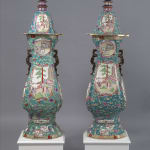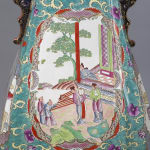

A Rare & Impressive Pair of Mason’s Ironstone Vases, Circa 1829-1845
A rare and impressive Pair of C.J. Mason & Co Granite China hall or alcove Vase and Cover, of panelled pear shape, the corners canted and forming a loop at the rim upon similarly canted shaped circular foot beneath a high domed cover with four storey pagoda finial, the body printed in black with four reserves of Chinese fan pattern, oriental figures in a chariot; a boy on a buffalo with other figures, and a chinoiserie landscape, two figures riding mules on a bridge to the fore, with other smaller scattered reserves of flowering peonies and double landscapes all upon a ”bandana” type ground of pink flowers and yellow painted scrolling foliage and dogs of fo heads, the whole pagoda reserved upon a beautiful and highly rare sea green ground, with twin scroll handles in iron red and enriched with gold.
Mark
Black printed mark of façade of building
FENTON STONE CHINA WORKS CJM & CO GRANITE CHINA
STAFFORDSHIRE POTTERIES, to the underside of one and inside the cover of the other.
The frontice of the Fenton Works building has been used as part of the mark on these exceptional vases. The façade was described by Simeon Shaw in the History of the Staffordshire Potteries ‘The front warehouse is four stories high, is fireproof, and has the most beautiful façade of any in the district’.
Miles Mason, b1752, inherited Richard Farrar’s retail business, through marriage to Farrar’s daughter Ruth in 1782, located at 131 Fenchurch Street, London, a prominent member of trade companies he rose to become master of the Glass Sellers Company in 1793. Along with glass, Mason’s Stock included Chinese Export porcelain imported solely through the East India Company. The East India Company ceased importation of Oriental porcelain circa 1792 due in part to a rise in importation taxes or duties.Miles along with the other London retailers sought stock from the British pottery industry. Mason began manufacturing wares in his own right in the main from his workshops at Lane Delph, Staffordshire. The porcelain wares produced were often intentionally decorated in the manner of the Chinese Export wares with Chinoiserie landscapes in underglaze blue. It is interesting to note the Pagoda finial on these vases, whilst Chinese export models of pagodas are known during the eighteenth century, the great Pagoda at Kew was viewed as a wonder here in England during the early nineteenth century and it is therefore quite possible that this was the design influence for these very rare models.
Exhibitions
THESE VASES WERE EXHIBITED AT “CHINESE WHISPERS: CHINOISERIE IN BRITAIN 1650-1930” (SEE COVER OF MUSEUM’S EXHIBITION CATALOGUE FOR PHOTOGRAPH AND P.106, EX. NO. B106) AT THE BRIGHTON MUSEUM AND ART GALLERY (3 MAY – 2 NOVEMBER 2008).Literature
Blake Roberts: Gaye Blake Roberts
Mason’s the First Two Hundred Years, published by Merrell Holberton, 1996.
Godden Ed I: Geoffrey A. Godden,
The Illustrated guide to Mason’s Patent Ironstone China,Barrie & Jenkins 1971.
Godden Ed II: Geoffrey A. Godden, F.R.S.A.,
Godden’s Guide to Mason’s China and the Ironstone Wares, published by Antique Collector’s Club, 1991.
Join our mailing list
* denotes required fields
We will process the personal data you have supplied in accordance with our privacy policy (available on request). You can unsubscribe or change your preferences at any time by clicking the link in our emails.

